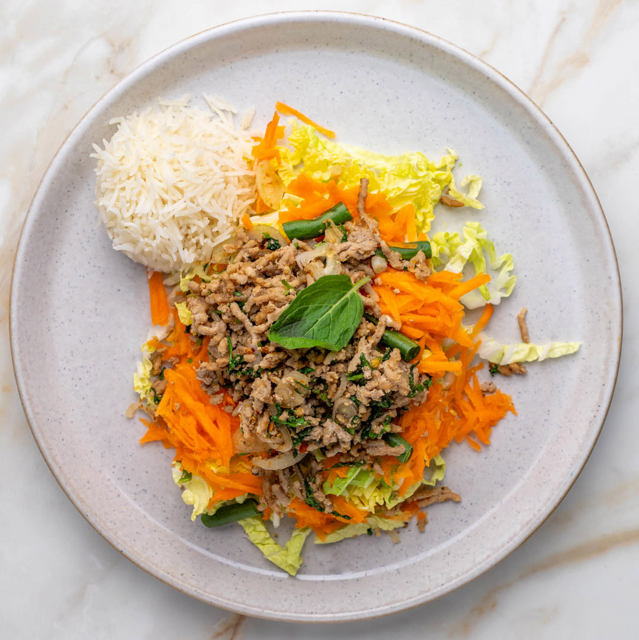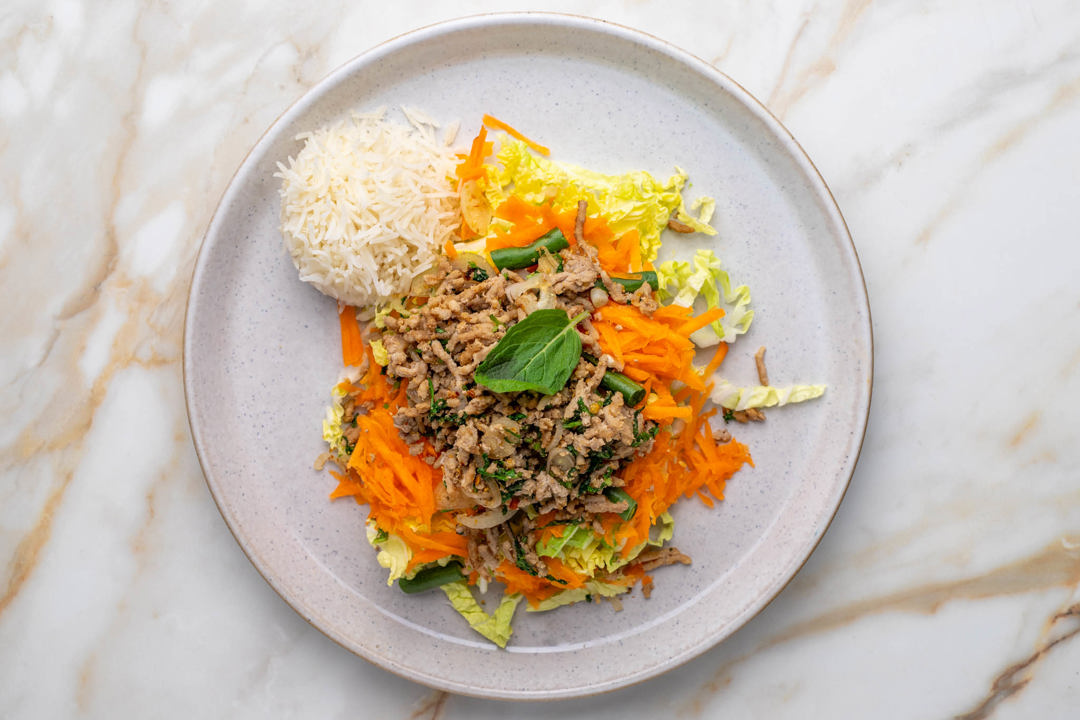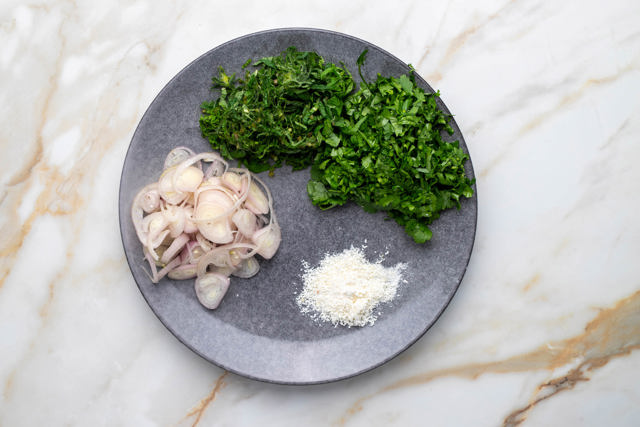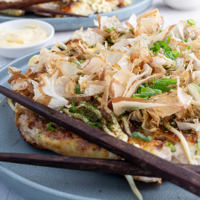Thai food is known for its punchy combination of sweet, salty, sour and chilli flavours, and this Pork Laab lives up to those expectations and then some!
Made with minced pork, mint, chilli, fish sauce and other flavourful ingredients, this dish makes a great healthy midweek meal, coming together in around 15 minutes.
Also known as "larb", laab is a savoury minced meat salad which has its origins in Laos and is closely associated with the Lao people. Its history dates back centuries and over time, laab's popularity spread to neighbouring Thailand. The preparation between Lao and Thai laab is similar, with the main difference being that Lao laab tends to use coarser meat and slightly different flavours.
What is Laab/larb?
Laab - also known as larb - is a minced meat salad which is popular in Thailand and Laos. It’s flavoured with herbs like mint and coriander and can be made into a more substantial salad with the addition of rice and green vegetables like beans and cabbage.
Laab Ingredients
For the laab
- Mince - this recipe is for pork laab, but you could easily use chicken mince as well. Whichever mince you use, make sure it has some fat because otherwise the salad will be dry.
- Shallots - shallots bring a sweet oniony flavour to the dish. If you’re able to get Thai shallots - known as Hom Dang - get them, because the flavour profile is a little different. Regular European shallots are a fine substitute.
- Palm sugar - Thai food is all about balancing heat with salty, sweet and sour flavours. The palm sugar brings the sweetness.
- Fish sauce - as above, but this brings the saltiness and umami.
- Lime juice - this brings the sourness to the dish
- Chilli flakes - this brings the heat to the dish. Regular red pepper flakes are fine, but if you can get hold of some dried Thai chilli you can toast them in a frying pan until hot and fragrant and then blend in a spice grinder.
- Rice - one of the core tastes of laab is toasted rice, which is freshly toasted and ground before adding to the salad. Thai sticky rice is traditional, but if you can’t find it any long grain rice like jasmine or basmati will be fine.
- Mint - the dominant herb flavour in the salad, it pairs very well with the other ingredients
- Coriander / cilantro - this brings additional flavour to the salad, but if you’re not a fan of the taste, feel free to leave it out. Traditionally, sawtooth coriander - also known as "culantro"- would be used, so if you can get that give it a try.
For the salad
The salad ingredients are almost universally green, but I like to add some grated carrot. The recipe uses:
- Carrots - I grate these.
- Green beans - washed and sliced, but eaten raw.
- Wombok cabbage - I thinly slice this.
Some other ideas for you:
- Crisp lettuce like iceberg or cos/romaine
- Cucumber
- Snake beans
- Grated zucchini - make sure you wring the water out first
Laab is usually served with a vegetable salad on the side to make it a complete and balanced meal - otherwise it’s a very meat heavy dish.
How to make Laab
Mise en place - peel and thinly slice the shallots, roll the mint up and thinly slice (this is called chiffonade), grate or thinly slice the palm sugar, juice the lime and finely slice the coriander/cilantro (1). Prepare your salad vegetables (2).
Make the toasted rice by using a small frying pan or skillet and heating over medium high. Add the rice (1) and toss regularly until a deep golden toasty brown (2). Remove from frying pan and place into a mortar and pestle (3) or spice grinder - and grind to a powder with a little texture (4).
Cook the pork by adding 1/4 cup of water to a frying pan or skillet and the mince and then heat to medium and slowly cook. Stir regularly and add a little more water as needed - the meat should not be coloured.
Add aromatics - when the pork is cooked, remove to a mixing bowl. While the pork is still warm, add the shallots, mint and coriander/cilantro and stir them through and allow 30 seconds for the residual heat to soften them. Add the lime juice, chilli, fish sauce and palm sugar, and give everything a good stir to combine.
Adjust seasoning - adjust the salt/sour/heat/sweetness to your taste by adding additional fish sauce, lime juice, chilli and palm sugar to suit your taste. This dish should be warm to your tastes.
Serve warm alongside some salad vegetables and, if you want a more substantial meal, add some rice.
How can I change this to be laab gai (chicken laab)?
Just swap out the pork mince for chicken mince. The flavour and ingredients of the two dishes are otherwise the same. Don't use a mince made exclusively from chicken breast because there won't be enough fat and the meat will be dry.
Can I skip the toasted rice?
Yes, but the toasted rice adds an important flavour to the laab. It’s not difficult to do, so if you have the time you should do it.
Should laab be spicy?
Laab should be somewhat spicy, but adjust it to your tastes. It shouldn’t blow your head off from chilli head. If you’re not a chilli fan, leave the chilli out.
How can I make vegetarian laab?
You can use a vegetarian mince substitute, mushrooms or crumbled tofu and follow the recipe, and potentially use a vegetarian or vegan fish sauce depending on your diet.
What to do with leftovers?
You can freeze this but due to the fresh herbs the texture is negatively affected. Leftovers will last in the fridge for a few days, but take note of the best before date on your mince. Keep any leftovers in the fridge covered.
What to serve with laab?
I like to serve this with additional salad vegetables - see above for suggestions - and a little rice.

Thai Pork Laab
| Prep | Cook | Total |
|---|---|---|
| 10 mins | 10 mins | 20 mins |
- 2 tbsp Thai sticky rice or any long grain rice see note 1
- 500g pork mince ideally 80/20, see note 2
- 80g shallots use Thai shallots "Hom Dang" if you can get them
- 2 tbsp fish sauce
- 60ml lime juice roughly 2 normal limes
- 2 tbsp palm sugar, grated or thinly sliced sub for brown sugar if needed
- Chilli flakes see note 3
- 30g coriander/cilantro see note 4
- 15g mint leaves
- Cooked rice
- 200g wombok/nappa cabbage, thinly sliced
- 4 carrots, peeled and grated
- 200g green beans, sliced remove the ends of the beans first if needed
- Prepare the vegetables - thinly slice the shallots, roll the mint leaves up and thinly slice and thinly slice the coriander/cilantro (including the stalks).
- Make the rice powder - heat a small skillet or frying pan over medium heat and add the rice. Toast until a dark, golden brown and smells like popcorn. Grind in a pestle and mortar or spice grinder to a fine grind, but not a fine powder.
- Cook the pork - Preheat a large skillet or frying pan over medium heat add 1/4 cup of water to the frying pan and add the mince. Break the mince up using the back of your spoon while cooking and stir occasionally. Don’t brown the mince and if all the water evaporates add a little more.
- Add aromatics - when the mince is cooked, remove the pan from the heat. While the pan is still warm, add the shallots and stir them through and allow 30 seconds for the residual heat to soften them. Add the lime juice, chilli, fish sauce and palm sugar. Add the coriander/cilantro and the mint, and give everything a good stir to combine.
- Adjust seasoning - adjust the salt/sour/heat/sweetness to your taste by adding additional fish sauce, lime juice, chilli and palm sugar to suit your taste. This dish should be warm to your tastes.
- Serve warm alongside cabbage, carrots, beans and some rice.
- Rice - The rice is used to make "kao kua" which is a powder made from toasted rice. Traditionally Thai sticky rice would be used, but use whichever long grain rice you have such as jasmine or basmati. You can omit this, but its flavour is an important component of the dish.
- Mince - because no oil is used when cooking the mince, to prevent it drying out I suggest using 80/20 fat to lean minced meat. You can use the same recipe for chicken if you’d prefer.
- Chilli flakes - aka red pepper flakes are perfectly fine to use for this dish, but if you can get some Thai dried chillis you can toast them in a frying pan until fragrant and then grind in a pestle and mortar or spice grinder for a more authentic taste. Add a little at a time to get the dish to your preferred heat level.
- Coriander/cilantro - look, I get it - a lot of people don’t like the taste. Leave it out if you want. If you can get hold of sawtooth coriander - also known as culantro - use that as that’s what would ordinarily be used.
- Water is used as the thermal transfer medium rather than oil as is common. It’s important to keep a little oil in the pan to help prevent the meat from drying out and to help it cook evenly.



























